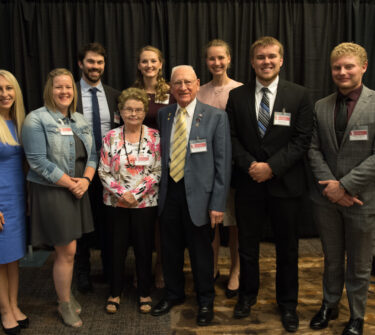

Lauren Van Hove enrolled at the USD Sanford School of Medicine in 2018. She comes from a town of 64 residents in northern Minnesota. Being from a small community, she was drawn to the medical school due to its strong reputation and appreciates the focus on rural communities and serving the underserved.
In 2017, the USD Sanford School of Medicine received the Spencer Foreman Award for Outstanding Community Service, awarded by the Association of American Medical Colleges. This award recognizes the efforts of USD Sanford School of Medicine to partner with South Dakota rural communities to serve their citizens, specifically those living on or near Native American reservations. Receiving this award is a top honor for a medical school.
While still at the beginning of her medical education, Van Hove could see herself working in a rural community, like her hometown in Minnesota.
“I loved growing up in a smaller community,” Van Hove said. “USD is focused on fostering physicians ready to serve these underserved communities, so I’m confident that if I choose to go in that direction, I will be prepared.”
“We both feel we owe a great debt to our universities,” Dr. Fenske said. “They made my life for me.”
Beginning a Lifelong Career
Dr. Arnold Fenske, M.D., FACP, is a 1952 USD graduate and understands the importance of supporting the next generation of physicians, especially those needed to serve smaller communities. Dr. Fenske and his seven sisters grew up on a South Dakota farm and attended elementary and high school in the nearby small town of Hetland. Upon graduating from high school in 1947, he explored the possibility of becoming a veterinarian, but was soon discouraged upon finding that the veterinary school at Iowa State University could only admit a small number of out-of-state students.
This led Dr. Fenske to write a letter to Dr. Donald Slaughter, dean of USD Medical School at the time. Dr. Fenske received an encouraging reply that even though he was a graduate of a high school that didn’t offer chemistry or physics courses, he should still enroll in USD pre-med courses and pursue higher education.
Following Dr. Slaughter’s advice, Dr. Fenske completed pre-med and medical school courses at USD. Once again heeding the advice of Dr. Slaughter, Dr. Fenske applied to the University of Iowa to transfer and complete the final two years of medical school.
Strong faculty connections, like the one Dr. Fenske and Dr. Slaughter shared, continue to be a hallmark of receiving a USD education.
“I don’t know if I have met one faculty person yet that isn’t completely immersed in wanting you to do well as a student here,” Van Hove explained.
Dr. Fenske graduated and received his medical degree from the University of Iowa in 1954. A few weeks later, he wed another Iowa graduate, Alanna, who was a nurse at the university hospital. They have been soulmates for 65 years.
After completing a one-year rotating internship at Wayne County General Hospital near Detroit, Dr. Fenske was drafted for military service and served two years in Germany as a U.S. Army medical officer, caring for troops and military dependents. After his discharge from military duty and completing three years of internal medicine residency training at Detroit Receiving Hospital, he joined the internal medicine staff at Winona Health – formerly called Winona Clinic – in Winona, Minnesota in 1960. He practiced internal medicine for the next 54 years until his retirement in 2014.
During 13 years of his practice, he was associated with the University of Minnesota as a clinical associate professor of medicine teaching Rural Physician Associate Program (RPAP) students, which involved students spending their third years in medical school caring for patients with Dr. Fenske.
In 1973, Dr. Fenske started a dialysis unit at the Winona hospital for patients with chronic renal failure. This has gradually grown to now serve 50 patients.
“A university isn’t extraordinary just because of its curriculum; it’s extraordinary because of the people that passionately support it,” Van Hove said. “I firmly believe USD is extraordinary because of our generous supporters that give back to the university.”
Supporting the Next Generation
USD and the medical school launched Dr. Fenske on a long and satisfying lifetime career for which he and Alanna are incredibly grateful. They began to consider how they would leave a lasting impact at USD, a place that has had a significant impact on Dr. Fenske’s life.
In 2008, Dr. Fenske and Alanna established the Dr. Arnold W. & Alanna J. Fenske Scholarship Endowment to provide incoming medical students with renewable scholarships. Before creating the endowment, they gave often and frequently to the Sanford School of Medicine, but the endowment has increased the impact they are having at USD.
“We both feel we owe a great debt to our universities,” Dr. Fenske said. “They made my life for me.”
Van Hove said students greatly appreciate the scholarship support as it makes attending USD possible. Her husband, Chris, is also a medical student. Because they are both attending medical school, creating a budget and focusing on their monthly expenses was essential. If not for the generous scholarship support, she and Chris couldn’t attend medical school.
“The support provides financial stability for our family,” Van Hove said. “We couldn’t be more thankful for the scholarships we have received.”
Along with financial giving, it’s appreciated when alumni and donors give back through their time. For Van Hove and her classmates, it’s motivating when doctors visit class because it allows them to hear from people who were once in their seats and now have successful careers.
“A university isn’t extraordinary just because of its curriculum; it’s extraordinary because of the people that passionately support it,” Van Hove said. “I firmly believe USD is extraordinary because of our generous supporters that give back to the university.”
Support students like Lauren!
Make a gift to the USD Sanford School of Medicine
